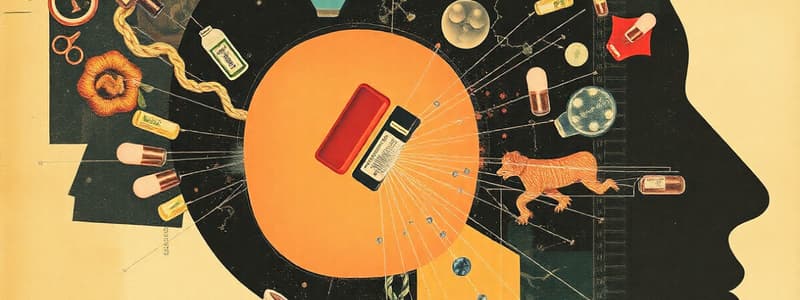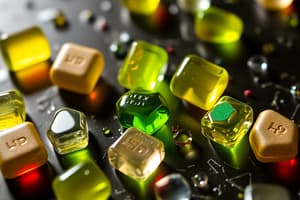Podcast
Questions and Answers
What is one of the primary uses of scopolamine in medical practice?
What is one of the primary uses of scopolamine in medical practice?
- Induction of twilight anesthesia (correct)
- Treatment of severe depression
- Stimulation of appetite
- Management of schizophrenia
What type of receptor does Lysergic Acid Diethylamide (LSD) primarily bind to in the brain?
What type of receptor does Lysergic Acid Diethylamide (LSD) primarily bind to in the brain?
- Norepinephrine receptors
- GABA receptors
- Dopamine receptors
- 5-HT2A receptors (correct)
What is a notable psychological effect of using psilocybin?
What is a notable psychological effect of using psilocybin?
- Complete sedation of the user
- Inducing extensive long-term memory
- Enhanced treatment for PTSD and addiction (correct)
- Increased heart rate and blood pressure
Which substance is known for its empathogenic effects?
Which substance is known for its empathogenic effects?
Which of the following psychedelic compounds is derived from the morning glory plant?
Which of the following psychedelic compounds is derived from the morning glory plant?
What was one of the initial uses of MDMA when it was first developed?
What was one of the initial uses of MDMA when it was first developed?
Which of the following characteristics is associated with anticholinergic psychedelics like scopolamine at high doses?
Which of the following characteristics is associated with anticholinergic psychedelics like scopolamine at high doses?
Which of the following substances is NOT chemically similar to serotonin?
Which of the following substances is NOT chemically similar to serotonin?
What is a potential effect noted with the use of mescaline?
What is a potential effect noted with the use of mescaline?
Which phenomenon is associated with the use of serotonergic psychedelics like LSD?
Which phenomenon is associated with the use of serotonergic psychedelics like LSD?
Flashcards
Psychedelics
Psychedelics
Substances that cause profound changes in perception, thought, and mood.
Serotonergic psychedelics
Serotonergic psychedelics
Psychedelics that affect serotonin receptors in the brain, leading to altered perception.
LSD
LSD
A synthetic psychedelic drug chemically similar to ergot and serotonin.
Psilocybin/Psilocin
Psilocybin/Psilocin
Signup and view all the flashcards
Mescaline
Mescaline
Signup and view all the flashcards
MDMA
MDMA
Signup and view all the flashcards
5-HT2A receptors
5-HT2A receptors
Signup and view all the flashcards
Anticholinergic psychedelics
Anticholinergic psychedelics
Signup and view all the flashcards
Entactogens
Entactogens
Signup and view all the flashcards
Ololiuqui
Ololiuqui
Signup and view all the flashcards
Study Notes
Psychedelic Drugs: Classification and Effects
- Anticholinergic:
- Scopolamine (mAch antagonist): Low doses cause sedation, mild euphoria, and amnesia; high doses cause euphoria, hallucinations, and excitement. Peripheral effects include tachycardia, increased body temperature, and dry mouth. Used in twilight anesthesia.
Serotonergic Psychedelics
-
LSD (Lysergic Acid Diethylamide):
- Chemically similar to serotonin.
- Developed in the 1930s to explore therapeutic possibilities (vasoconstriction) and, later, as a model of psychosis.
- Binds to 5-HT2A receptors in the brain (prefrontal and cingulate cortex). Causes perceptual distortions (visual, auditory, space/time).
- Synthesized in 1938.
- Used in psychotherapy and by military in the 1950s-1970s.
- Illegal (felony-level possession) since 1968.
-
Ololiuqui:
- Seeds of morning glory.
- Psychedelic compound: lysergic acid amide (not the same as LSD).
-
Bufotenine:
- Alternative metabolite of serotonin.
- Found in people with psychiatric disorders (?).
- Found in the skin of toads of the genus Bufo.
-
Psilocybin/Psilocin:
- Found in "shrooms" (mushrooms).
- Renewed interest in their use as adjunctive treatment for depression, PTSD, addiction, and end-of-life anxiety.
Catecholamine-like Psychedelics
-
Mescaline:
- Chemically similar to norepinephrine and dopamine.
- Methoxy groups confer psychedelic properties by acting as agonists at the 5-HT2A receptor.
- Causes anxiety, visual distortions, and tremors.
-
Synthetic Methoxylated Amphetamine Derivatives (DOM, MDA, DMA, MDE, TMA, AMT, MDMA):
- Increase the release of or inhibit the reuptake of monoamines and acetylcholine.
- MDMA (Ecstasy):
-
Developed in 1914 for appetite suppression.
-
Tested by US military as a "brainwashing" drug in the 1950s.
-
Interest in its use as psychological treatment in the 1970s.
-
Popular among college students since the 1980s.
-
Effects include empathy, insight, enhanced communication, and transcendent religious experiences.
-
Potential for sympathomimetic effects (like anxiety), malignant hyperthermia, and neurotoxicity.
Antiglutamatergic Psychedelics
- Phencyclidine (PCP) and Ketamine:
- NMDA receptor antagonists.
- Can cause confusion, altered perception, stupor, and coma.
- Originally developed as safer anesthetic and analgesic agents.
Kappa Opioid Agonist
- Salvinorin A:
- Causes hallucinations and dysphoria.
Studying That Suits You
Use AI to generate personalized quizzes and flashcards to suit your learning preferences.




